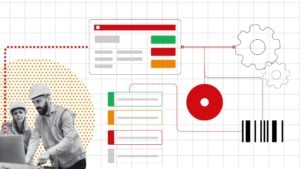Business Process Mapping is a great way to create clarity and efficiency in your business, but it’s not just a case of getting the whiteboards cleaned and the donuts stocked up!
The business process mapping project can bring your team together to focus on strategic goals, and help individuals see how they play a part in achieving those goals. The process mapping experience should be a ‘safe space’ for individuals to express their ideas about current business practices, and how things could be done better. The best ideas rarely come from the board-room, they develop where the work is done.
Some businesses have colleagues with experience in process mapping who can lead this as an internal project, whilst others lack the experience or capacity. At Flowlens we are experienced in working with companies to map processes and execute effective change management plans.
The following questions provide a practical framework for considering how to go about the business process mapping exercise, and critically, the change management factors that will ensure the outputs will actually make an impact.
General Business Situation
- What are the key goals or objectives for this process mapping initiative?
- What prompted the need for process mapping at this time?
- Are there specific pain points or areas of concern you’re hoping to address?
Organisational Structure
- Can you describe the organisational structure across the business?
- Are there any departments or teams duplicated across multiple locations?
- Who are the key stakeholders and decision-makers for this change project?
- Is there a central operations team, or is each site managed independently?
Current Process Landscape
- Which business processes are in scope for mapping (e.g., sales, finance, HR, operations)?
- Are there existing process documents or SOPs available for review?
- How standardised are the current processes across the sites?
- How are processes currently tracked, documented, or communicated?
Technology and Tools
- What systems or tools are used for managing operations (e.g., ERP, CRM, project management)?
- Are there any automation tools in place?
- Do different sites use different systems or tools?
- Are you looking to integrate or optimise any current tools as part of this initiative?
Process Mapping Expectations
- What level of detail do you expect in the process maps (high-level vs detailed workflows)?
- Are you looking for recommendations on process improvement, or just documentation?
- Who will use these maps, and for what purpose (training, auditing, optimisation, etc.)?
- Who will establish and maintain new working norms based on the findings?
Understanding the Impact of Business Process Mapping
Process Mapping is often among the key first steps of a larger change management project. Change can be a scary word for many people. It’s essential to identify the nature and scale of the change stemming from the mapping exercise:
- Are processes being standardised across all sites?
- Will roles or responsibilities shift?
- Are new tools, systems, or automation being introduced?
- Are KPIs clear currently? Will KPIs or reporting lines change?
- Will people have a say in what changes are implemented?
Understanding the “what” and “who” affected by the changes allows you to design targeted change management interventions.
Stakeholder Engagement
Humans don’t like change, sometimes even if the benefits of change are clear. A Business Process Mapping exercise can raise suspicions and rumours if it’s purpose is not clearly communicated. Early and consistent involvement across the team ensures buy-in and reduces resistance:
- Start by defining clear measurable goals for where you want the business to be in 5 years.
- How will people be incentivised to care? “What’s in it for me?” Can the team share in the profits of the more efficient operations for example?
- Identify champions at each site and in each major department—people who understand the day-to-day and can advocate for the process.
- Use stakeholder influence to reinforce messaging and address local concerns frequently.
Training and Support
Once new or revised processes are ready, employees need to know how the business will provide support to adopt them:
- Develop tailored training materials—especially if systems, roles, or workflows are changing.
- Provide hands-on walkthroughs or role-based simulations to make new processes relatable.
- Set up a help desk or point-of-contact network at each site for ongoing support.
- Plan refresher training to reinforce learning within 6-8 weeks. Humans don’t learn everything in one go!
Pilot and Phased Implementation
Rolling out changes in stages allows you to learn and adapt:
- Pilot revised processes at one site or within one department first.
- Collect feedback, tweak the process, and use success stories to encourage adoption elsewhere.
- Gradually expand to other locations or departments.
Monitoring and Reinforcement
Changes must be sustained beyond implementation:
- Establish clear ownership and accountability for each process.
- Define KPIs and metrics to track process performance and adoption rates.
- Celebrate wins, recognise adopters, and regularly revisit processes for ongoing improvement.
Cultural and Behavioral Alignment
Changes in process often require shifts in mindset or behavior:
- Reinforce desired behaviors through performance evaluations, incentives, and recognition programs.
- Align management practices and leadership behavior with the new processes.
- Create a continuous improvement culture where feedback and innovation are encouraged.
- Remember – “If you can’t change the person – change the person.”
If we can help with any aspect of the planning or execution of your business process mapping project, please contact us.
Plus, why not download our free book, F.E.A.R.L.E.S.S. Digital Transformation, which covers the 8 essential steps SME manufacturers should follow when planning and implementing new digital improvements. Click here to download!





